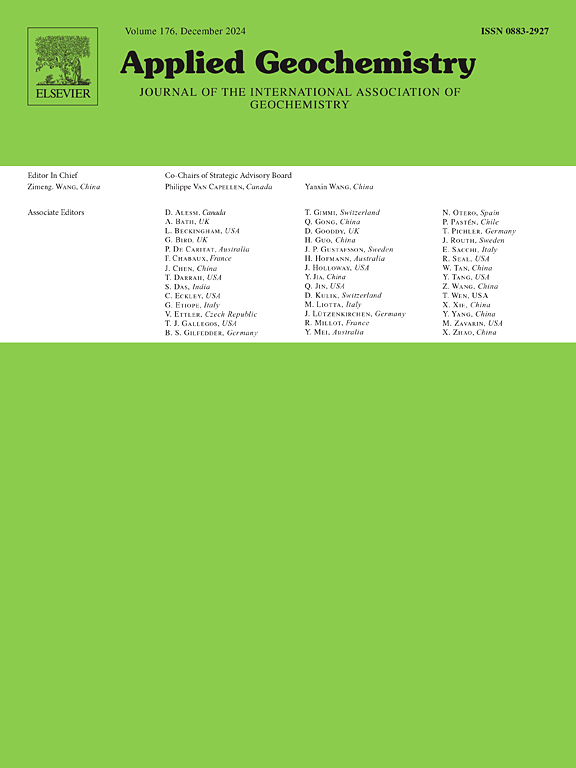Assessment of landscape impact on snow chemical composition in terms of mineral geochemical exploration
IF 3.1
3区 地球科学
Q1 GEOCHEMISTRY & GEOPHYSICS
引用次数: 0
Abstract
In areas with cold climate seasonal snowpack is an attractive sampling material for geochemical exploration of deep mineral accumulations. However, previous studies on assessment of exploration efficiency of snow cover have paid little attention to snow composition variability conditioned by local landscape structure.
The layered sampling of snow sections was performed in different landscape settings of the local area. The research area is characterized by the absence of ore mineralization zones and low anthropogenic load. The physical-chemical parameters and concentration of wide range of elements were identified in snowmelt. Multi-component data was integrated by means of factor principal component analysis. Besides, additive and differential geochemical indexes were used. The classification snow models were developed using hierarchical cluster analysis. The variance of chemical elements distribution and factor models of geochemical pattern were compared before and after reduction of background fluctuation. In terms of variation coefficient values of chemical elements the area has background parameters of chemical inhomogeneity. In total variance a lateral component prevails over a vertical one. The highest concentrations of chemical elements were found in snow section of forest landscape. It is necessary to take into account the fact of geochemical background fluctuation when interpreting the data of metal assay snow survey.
After the reduction of lateral geochemical background fluctuation, the factor model has better classified the chemical elements in terms of their connection with soluble and insoluble occurrence forms. The values of differential index of liquid and solid phases have a similar satisfactory vertical variability in different landscapes. The analysis of chemical elements concentration reveals snow horizons that were or are affected by thaw and percolating water. The snow bottom layer, which is sampled at geochemical exploration, is not strong influenced by elution.
从矿物地球化学勘查角度评价景观对积雪化学成分的影响
在寒冷气候地区,季节性积雪是深部矿床化探中极具吸引力的采样材料。然而,以往的积雪勘探效率评价研究很少关注局部景观结构条件下的积雪组成变异性。在当地不同的景观设置下,对雪段进行分层采样。研究区无矿化带,人为负荷低。确定了融雪中多种元素的理化参数和浓度。采用因子主成分分析方法对多成分数据进行整合。此外,还采用了加性和差异性地球化学指标。采用层次聚类分析方法建立分类雪模型。对比了背景波动减小前后化学元素分布和地球化学格局因子模型的方差。在化学元素变异系数值方面,该区域具有化学不均匀性的背景参数。在总方差中,横向分量大于垂直分量。森林景观中化学元素浓度最高的是雪区。在解释金属测雪资料时,有必要考虑地球化学背景波动的事实。在减少横向地球化学背景波动后,因子模型对化学元素与可溶性和不溶性赋存形式的联系进行了较好的分类。在不同的景观条件下,液相和固相的差指数具有相似的、令人满意的垂直变异性。对化学元素浓度的分析揭示了曾经或正在受到解冻和渗水影响的雪层。化探取样的雪底层受淋洗液的影响不大。
本文章由计算机程序翻译,如有差异,请以英文原文为准。
求助全文
约1分钟内获得全文
求助全文
来源期刊

Applied Geochemistry
地学-地球化学与地球物理
CiteScore
6.10
自引率
8.80%
发文量
272
审稿时长
65 days
期刊介绍:
Applied Geochemistry is an international journal devoted to publication of original research papers, rapid research communications and selected review papers in geochemistry and urban geochemistry which have some practical application to an aspect of human endeavour, such as the preservation of the environment, health, waste disposal and the search for resources. Papers on applications of inorganic, organic and isotope geochemistry and geochemical processes are therefore welcome provided they meet the main criterion. Spatial and temporal monitoring case studies are only of interest to our international readership if they present new ideas of broad application.
Topics covered include: (1) Environmental geochemistry (including natural and anthropogenic aspects, and protection and remediation strategies); (2) Hydrogeochemistry (surface and groundwater); (3) Medical (urban) geochemistry; (4) The search for energy resources (in particular unconventional oil and gas or emerging metal resources); (5) Energy exploitation (in particular geothermal energy and CCS); (6) Upgrading of energy and mineral resources where there is a direct geochemical application; and (7) Waste disposal, including nuclear waste disposal.
 求助内容:
求助内容: 应助结果提醒方式:
应助结果提醒方式:


